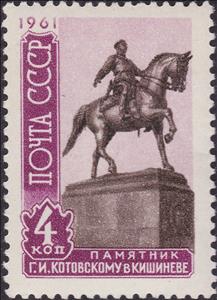Stamp: Monument of G.I.Kotovsky in Kishinev (Soviet Union, USSR 1961)
Monument of G.I.Kotovsky in Kishinev (Soviet Union, USSR 1961)
01 January (Soviet Union, USSR ) within release 100th anniv. of the scientific magazine "Vokrug Sveta" goes into circulation Stamp Monument of G.I.Kotovsky in Kishinev face value 4 Russian kopek
| Stamp Monument of G.I.Kotovsky in Kishinev in catalogues | |
|---|---|
| Michel: | Mi:SU 2530 |
Stamp is vertical format.
Also in the issue 100th anniv. of the scientific magazine "Vokrug Sveta":
- Stamp - Agricultural Achievements. face value 10;
- Stamp - First Manned Space Flight (12-IV-1961) face value 10;
- Stamp - Birth Centenary of Nansen. face value 6;
- Stamp - Sculpture "Worker and Kolkhoz Woman" face value 10;
- Stamp - Monument of T.G.Shevchenko in Kharkiv face value 4;
- Stamp - 100th aniversary of "Around the World" magazine face value 6;
- Stamp - Glory to the CPSU! Glory to the Communist Party! face value 1;
- Stamp - National Hero of Italy Giuseppe Garibaldi (1807-1882) face value 6;
- Stamp - Monument of N. A. Schors in Kiev face value 2;
- Stamp - Birth Centenary of Epos "Kalevipoeg" face value 4;
- Stamp - Agricultural Achievements. face value 3;
- Stamp - 7th Soviet Trade Unions Spartakiad face value 6;
- Stamp - 200th Birth Aniversary of A.D.Zakharov (1761-1811) face value 4;
- Stamp - 15th Anniversary of International Union of Students. face value 6;
- Stamp - Space ship-satellite "The East II" face value 4;
- Stamp - Harvester driver face value 1;
- Stamp - 300th Anniversary of Irkutsk. face value 4;
- Stamp - International Correspondence Week. face value 4;
- Stamp - Monument of G.I.Kotovsky in Kishinev face value 4;
- Stamp - 22nd Communist Party Congress face value 4;
- Stamp - 10th Anniversary of International Federation of Resistance F face value 4;
- Stamp - Amangeldy Imanov. face value 4;
- Stamp - 150th Birth Anniversar of Franz Liszt. face value 4;
- Stamp - The defense of Odessa, 1941 face value 4;
- Stamp - 44th Anniversary of Great October Revolution. face value 4;
- Stamp - Young Builders of Seven Years Plan. face value 6;
- Stamp - 250th Birth Anniversary of M.V.Lomonosov. face value 10;
- Stamp - Young Builders of Seven Years Plan. face value 4;
- Stamp - 25th Anniversary of Constitution. face value 4;
- Stamp - Kazakh national costumes face value 3;
- Stamp - 120th Birth Anniversar of Andrei Pumpur. face value 4;
- Stamp - 15th Anniversary of Bulgarian Republic. face value 4;
- Stamp - Defeat the enemy near Moscow, 1941 face value 4;
Stamp Monument of G.I.Kotovsky in Kishinev it reflects the thematic directions:
Sculpture is the branch of the visual arts that operates in three dimensions. Sculpture is the three-dimensional art work which is physically presented in the dimensions of height, width and depth. It is one of the plastic arts. Durable sculptural processes originally used carving (the removal of material) and modelling (the addition of material, as clay), in stone, metal, ceramics, wood and other materials but, since Modernism, there has been almost complete freedom of materials and process. A wide variety of materials may be worked by removal such as carving, assembled by welding or modelling, or moulded or cast.
A monument is a type of structure that was explicitly created to commemorate a person or event, or which has become relevant to a social group as a part of their remembrance of historic times or cultural heritage, due to its artistic, historical, political, technical or architectural importance. Examples of monuments include statues, (war) memorials, historical buildings, archaeological sites, and cultural assets. If there is a public interest in its preservation, a monument can for example be listed as a UNESCO World Heritage Site. The Palgrave Encyclopedia of Cultural Heritage and Conflict gives the next definition of monument:
The horse (Equus ferus caballus) is one of two extant subspecies of Equus ferus. It is an odd-toed ungulate mammal belonging to the taxonomic family Equidae. The horse has evolved over the past 45 to 55 million years from a small multi-toed creature, Eohippus, into the large, single-toed animal of today. Humans began to domesticate horses around 4000 BC, and their domestication is believed to have been widespread by 3000 BC. Horses in the subspecies caballus are domesticated, although some domesticated populations live in the wild as feral horses. These feral populations are not true wild horses, as this term is used to describe horses that have never been domesticated, such as the endangered Przewalski's horse, a separate subspecies, and the only remaining true wild horse. There is an extensive, specialized vocabulary used to describe equine-related concepts, covering everything from anatomy to life stages, size, colors, markings, breeds, locomotion, and behavior.


